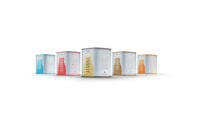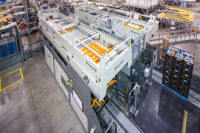How Linde helps Wolverine Packing solve a chilling-related packaging problem
Wolverine also realized benefits in sanitation as part of its overall food safety program.

Wolverine Packing Co., Detroit, Mich., sells more than 500 million pounds of protein products a year, and prides itself on logistics and efficiency. It ships boxed beef, pork, poultry, lamb, portioned cuts and processed meats to foodservice and retail wholesalers nationwide, and typically ships the day after order.
The company’s No. 1 product is fresh ground beef formed into patties and 5-pound bricks, so mixer chilling is key to quality production at high volumes. In September 2018, Wolverine asked the food team from Linde LLC, Bridgewater, N.J., to investigate a chilling-related packaging issue. By December 2018, Wolverine not only had a solution, but also one that yielded multiple advantages.
The problem
Wolverine’s twin mixers needed to run near capacity 16 hours a day to meet growing demand for fresh ground beef products. Essentially, the 3,000-pound mixers needed to move faster than the current carbon-dioxide (CO2) chilling system would allow.
In the bottom-injection (BI) chilling process, liquid cryogen is injected from multiple points at the bottom of the mixer/blender. With CO2, fine solid CO2 particles (i.e. dry ice) remove heat as they work their way through the batch. During blending, the particles shrink as they sublimate to CO2 gas and further chill the ground beef. However, if the CO2 does not fully sublimate, it can create what looks like “leakers.” Moisture from the meat can accumulate in the voids left by the CO2 and red liquid is visible through the packaging.
“Any processor can effectively use CO2 if the blender has enough time to sublimate it. But, we couldn’t afford that luxury. Our systems are running as close to 100% as we can get them, so we didn’t have time to wait,” says Jay Bonahoom, co-owner and vice president of Wolverine.
The actual mixer chill time with CO2 was about 90-120 seconds, according to Riley Cronk, food safety and quality control manager of Wolverine.
“Then it was another 30-60 seconds, post-chill, to ensure solid CO2 no longer exists within the batch,” she adds.
The solution
“In talking with Linde, we liked the idea of converting to nitrogen,” Bonahoom says.
With the liquid nitrogen (LIN) BI system there is no solid phase to the cryogen, so no extra wait time after mixer chilling.
Beyond product appearance in the package, the advanced LIN BI system offered strong logistic advantages. On any given day, Wolverine chills over 100 batches of ground beef. Saving at least 30 seconds per batch means a gain of at least 50 minutes of extra processing time per day. With a batch-to-batch turnaround time of 8-10 minutes at the plant, that represents at least five more batches/day, or an additional 30,000 pounds a day of mixer processing capacity for added flexibility.
Food safety advantages
Wolverine also realized benefits in sanitation as part of its overall food safety program. The operating end of the LIN BI system uses patented hygienic LIXSHOOTER injectors, designed to prevent the entrapment of particles in the injector orifice, which is common with standard injector nozzles.
“With the old CO2 injectors, daily cleaning and sanitizing was very important because the nozzles were open, and meat-fat buildup inside could provide a breeding ground for bacteria,” Cronk says. The daily procedure was to remove all the bottom injectors, clean and sanitize the nozzles and reattach them to the mixers during the sanitation shift.
“The new injectors use a plunger design that is never left opened, so it doesn’t ever have to be cleaned that way,” Cronk adds. “Before we had to clean inside the nozzles. Now the daily routine is to hose off the face of the LIXSHOOTER injectors when we clean the mixer. We still check the injectors, but from the sanitation side, there is no meat or fat buildup at all. The injectors are always closed unless there is a positive flow of nitrogen.”
The BI chilling system features Linde’s proprietary SmartChill cryogenic control, designed for positive flow of cryogen to all injectors for consistent equilibration of each batch and for consistent batch-to-batch temperatures. In this case, the ground beef is chilled from about 39oF to about 30oF in 90-120 seconds.
The plant operates six days a week and could not go long without mixer-chilling production. So, working with Wolverine, the Linde food team planned the installation over a 2-weekend, back-to-back period. One weekend, the LIXSHOOTER injectors were installed. Then the next weekend, the old CO2 equipment was removed.
“Throughout the process, the Linde food team was working behind the scenes, installing piping and exhaust fans while we were running production,” Cronk says. “It was just a 2-week span where they actually had to be inside the production room.”
Once the nitrogen supply tank was installed, the team optimized the control system for the processing parameters and trained plant personnel in safety and operating procedures. One worker operates both mixers and there are multiple shifts.
“The new chilling system definitely makes the job easier, and our operators like the new control panel,” Cronk says.
Fresh growth
Wolverine, founded more than 80 years ago, was one of only a few national meat packers that in the late 1990s began to emphasize fresh meats. While the company still sells a high volume of frozen product, fresh meat sales have skyrocketed over the past two decades. Ground beef, as well as sliced steak and portion-controlled products continue to drive growth.
Fresh beef remains Wolverine’s best seller because of efficiencies both in production as well as distribution.
“Logistics is one of our core strengths,” says Bonahoom. “We have trucks in all 48 states. So, we can ship fresh meat from Detroit to San Francisco, Miami or Portland, Maine, in a couple days. It comes off our production line in boxes that are loaded onto trucks the next morning. So, that’s part of how we got from essentially all frozen to fresh.”
To keep up with the burgeoning demand for fresh beef products, Wolverine is building another production plant in Detroit in 2019, which will include more mixing capacity with LIN BI chilling.
Looking for a reprint of this article?
From high-res PDFs to custom plaques, order your copy today!






